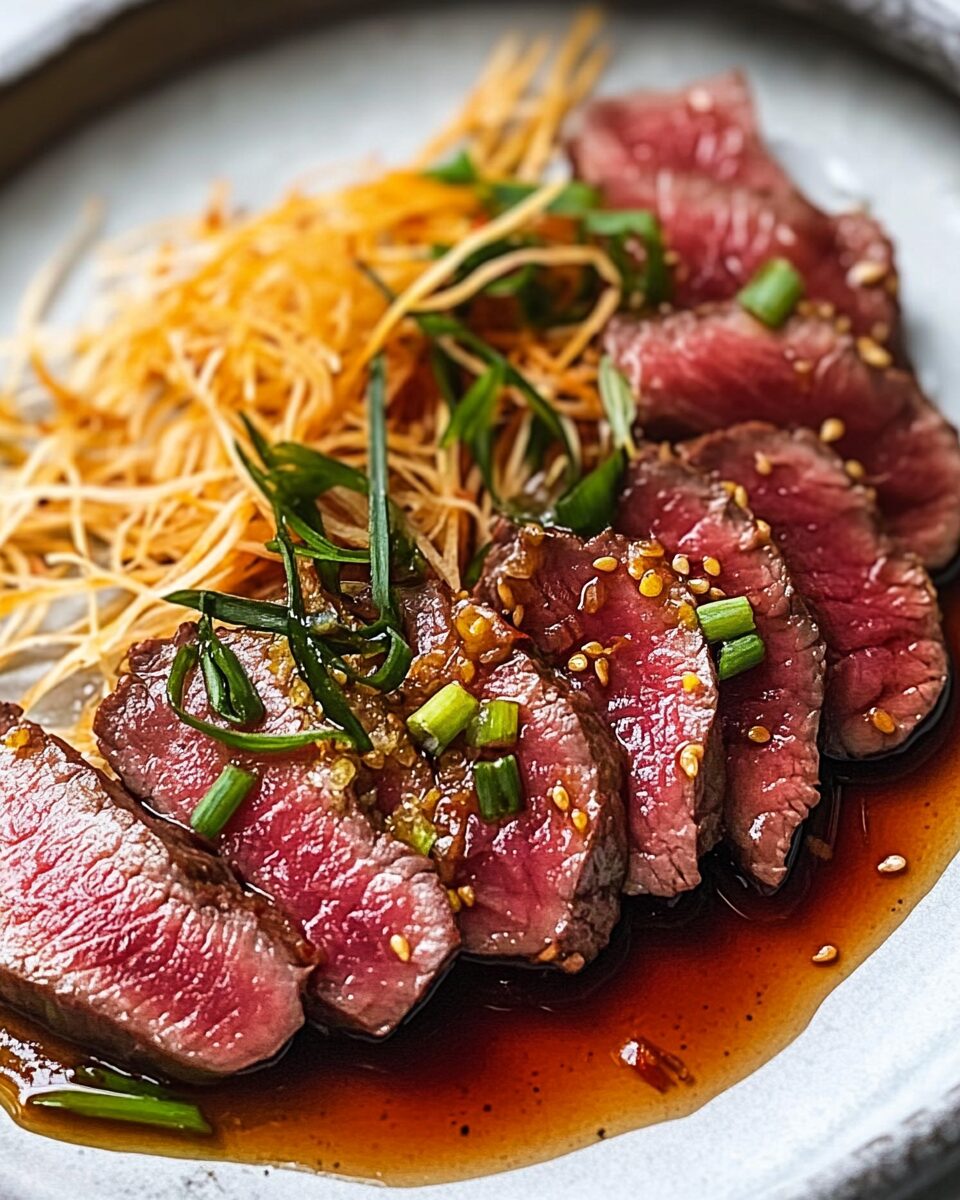Beef Tataki is a beautifully simple Japanese dish where the beef is lightly seared to create a tender, melt-in-your-mouth texture contrasted by a flavorful tangy citrus soy dressing. The thin slices showcase the vibrant pink interior, making it as visually striking as it is delicious.
This dish is perfect for those who love clean, fresh flavors with an umami punch. It works wonderfully as an appetizer or a light main course and comes together quickly, making it ideal for both casual meals and special occasions. Garnished with toasted sesame seeds and fresh spring onions, it offers a delightful crunch and a pop of color that elevates the entire experience.
Full Recipe:
-
300g (10 oz) beef sirloin or tenderloin, trimmed
-
2 tablespoons soy sauce
-
2 tablespoons citrus juice (yuzu or lemon)
-
1 tablespoon mirin
-
1 teaspoon sugar
-
1 clove garlic, minced
-
1 teaspoon fresh ginger, grated
-
1 tablespoon vegetable oil
-
2 spring onions, finely sliced
-
1 tablespoon toasted sesame seeds
-
Fresh coriander or microgreens (optional)
Directions:
-
In a small bowl, mix soy sauce, citrus juice, mirin, sugar, garlic, and ginger until sugar dissolves. Set aside.
-
Heat vegetable oil in a skillet over high heat until very hot but not smoking.
-
Sear the beef for 30-45 seconds on each side until the outside is browned but the inside remains rare.
-
Remove beef from the pan and immediately place on a plate. Let it rest for 5 minutes.
-
Using a very sharp knife, thinly slice the beef against the grain into 3-4mm slices.
-
Arrange slices on a serving plate and drizzle with the prepared citrus soy dressing.
-
Garnish with spring onions, toasted sesame seeds, and coriander or microgreens if using. Serve immediately.
Prep Time: 10 minutes | Cooking Time: 5 minutes | Total Time: 15 minutes
Kcal: Approximately 220 kcal per serving | Servings: 2-3 servings
Introduction to Beef Tataki: A Japanese Culinary Delight
Beef Tataki is a quintessential dish from Japanese cuisine that perfectly balances simplicity with sophistication. The name “tataki” translates to “pounded” or “hit,” referring traditionally to a method where the meat or fish is lightly seared or quickly grilled, then thinly sliced and served with a refreshing sauce. While tataki preparations can include fish like bonito or tuna, beef tataki has become increasingly popular worldwide due to its melt-in-the-mouth texture and fresh, vibrant flavors.
At its core, beef tataki is about celebrating the quality of the beef itself. The meat is seared just enough to create a caramelized outer crust while keeping the inside rare, tender, and juicy. This cooking technique allows the natural flavors of the beef to shine without overwhelming the palate with heavy cooking or excessive seasoning.
The Art of Searing Beef: Why Less is More
One of the defining characteristics of beef tataki is the quick searing process. The beef is typically exposed to very high heat for a brief period, often just 30 to 45 seconds on each side. This brief contact with heat forms a delicate crust through the Maillard reaction—a chemical reaction between amino acids and sugars that gives browned food its distinctive flavor.
The key is to ensure the inside remains nearly raw, lending an almost buttery texture that is soft and tender. Unlike traditional steak preparations that cook through to medium or well-done, beef tataki is more akin to a high-quality carpaccio or sashimi. This technique requires the use of premium cuts such as sirloin or tenderloin, which offer a fine grain and excellent marbling.
Flavor Profile: The Perfect Balance of Umami and Citrus Brightness
Beef tataki is traditionally paired with a citrus-based soy sauce dressing. The umami-rich soy sauce brings depth and savoriness, while the citrus element—often yuzu, lemon, or lime—adds a bright, refreshing tang that cuts through the richness of the beef. This balance is essential to the dish’s appeal, providing contrast that awakens the palate.
Additional aromatics like fresh ginger and garlic elevate the dressing further, infusing subtle warmth and complexity. Mirin, a sweet rice wine used in Japanese cooking, introduces a mild sweetness that balances the salty and acidic components beautifully.
The garnish plays a key role in texture and visual appeal. Thinly sliced spring onions add a sharp, fresh bite, while toasted sesame seeds contribute a nutty crunch. Sometimes microgreens or fresh coriander are added to introduce a herbal freshness that complements the other flavors.
Nutritional Aspects of Beef Tataki
Beef tataki is not only delicious but also relatively light and nutritious compared to many cooked beef dishes. Because the meat is only briefly seared, it retains much of its natural nutrients, including protein, iron, and essential vitamins like B12. The low cooking time means fewer calories from added fats or oils, making it a great choice for those who want a flavorful yet lean option.
The soy sauce-based dressing is low in calories but high in sodium, so it’s wise to use it in moderation if watching salt intake. The fresh citrus juice adds vitamin C, which enhances iron absorption from the beef, making it an even healthier meal option.
Cultural Significance and Origins
Tataki originated in Japan during the Edo period (1603–1868), primarily as a way to prepare fish and later meat in a manner that enhanced flavor and digestibility. The technique likely evolved as a method for preserving the freshness of raw ingredients while adding subtle cooked flavors.
Today, beef tataki is enjoyed both as a home-cooked delicacy and in fine dining restaurants across Japan and beyond. It exemplifies Japanese culinary principles: respect for the ingredients, balance of flavors, and elegant presentation.
How to Select the Best Beef for Tataki
Choosing the right cut of beef is crucial to the success of tataki. Tenderloin and sirloin are preferred due to their tenderness and fine grain. These cuts are lean yet have enough marbling to provide flavor without becoming tough.
When buying beef for tataki, it’s best to source high-quality, fresh meat, ideally grass-fed or wagyu beef if available, as these offer richer flavor and better texture. The beef should be bright red with minimal fat on the outside to ensure the sear is clean and even.
Tips for Perfectly Searing and Slicing Beef Tataki
Achieving the perfect sear requires a hot pan and a patient hand. The pan should be preheated to high heat, and the beef should be dry before placing it on the skillet to prevent steaming instead of searing.
After searing, the beef must rest briefly to allow the juices to redistribute, preventing dryness and ensuring each slice is juicy. The slicing itself requires a very sharp knife to cut against the grain, which shortens muscle fibers and maximizes tenderness.
Serving Suggestions and Pairings
Beef tataki is versatile and can be served as an appetizer, main course, or even part of a larger tasting menu. It pairs wonderfully with steamed rice or a simple salad of crisp greens dressed lightly with sesame oil and soy.
For beverage pairings, a dry sake or a light-bodied red wine complements the dish’s delicate balance. The acidity in these drinks echoes the citrus in the sauce and enhances the umami flavors of the beef.
Variations and Modern Twists
While traditional beef tataki stays close to the classic soy-citrus dressing, many chefs and home cooks experiment with additional flavors. Some add chili flakes or fresh chili for heat, others include a dash of ponzu sauce for a sharper citrus bite.
In fusion recipes, ingredients like avocado, pickled vegetables, or even crunchy tempura flakes are added to create texture contrasts. The dish’s adaptability makes it an exciting canvas for creativity while maintaining its authentic essence.
Health Benefits and Dietary Considerations
Beef tataki offers several health benefits. Its high protein content supports muscle maintenance and repair, while the minimal cooking preserves vitamins and minerals. The use of fresh herbs and ginger adds antioxidant and anti-inflammatory properties.
For those mindful of sodium intake, low-sodium soy sauce alternatives can be used without sacrificing flavor. The dish is naturally gluten-free if tamari or gluten-free soy sauce is selected, making it suitable for gluten-sensitive diets.
Why Beef Tataki Is Perfect for Entertaining
Due to its quick preparation and impressive presentation, beef tataki is a fantastic dish for entertaining. It can be prepared ahead of time, sliced just before serving, and plated elegantly with minimal fuss.
Its freshness and lightness make it a refreshing contrast to heavier dishes often served at dinners or parties. Guests will appreciate the tender texture and balanced flavors that feel indulgent without being overly rich.
The Growing Popularity of Beef Tataki Worldwide
As global palates expand to appreciate more nuanced flavors and textures, beef tataki has gained traction internationally. It is frequently featured in modern Asian fusion restaurants and sushi bars, appealing to diners looking for novel experiences beyond conventional steak or sashimi dishes.
Social media has also played a role, with food bloggers and chefs showcasing stunning beef tataki platings, inspiring home cooks to try this elegant dish.
Conclusion: Celebrating Simplicity and Flavor
Beef tataki is a beautiful example of how Japanese cuisine elevates simple ingredients through technique and thoughtful seasoning. This dish highlights the natural flavor and texture of premium beef, enhanced by a tangy, umami-packed dressing and fresh garnishes.
Its quick preparation, light yet satisfying profile, and stunning presentation make it a versatile favorite for both casual meals and special occasions. Whether you are a seasoned home cook or a curious food enthusiast, beef tataki offers a delicious gateway into the world of Japanese culinary art.
By embracing the balance of texture, flavor, and aesthetic, beef tataki reminds us that sometimes the best dishes are those that honor the essence of their ingredients with simplicity and care.





